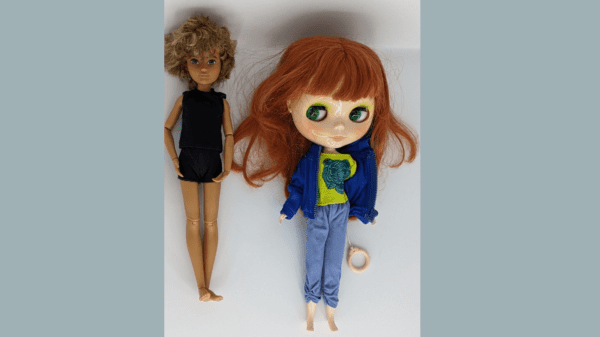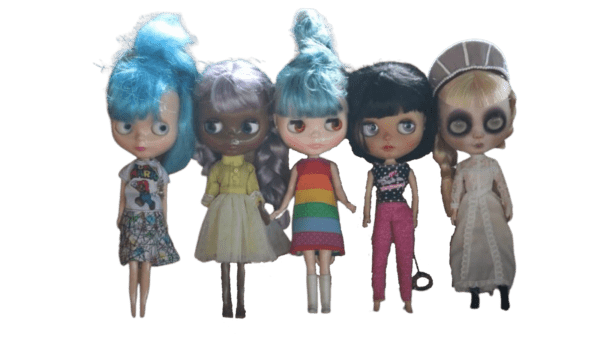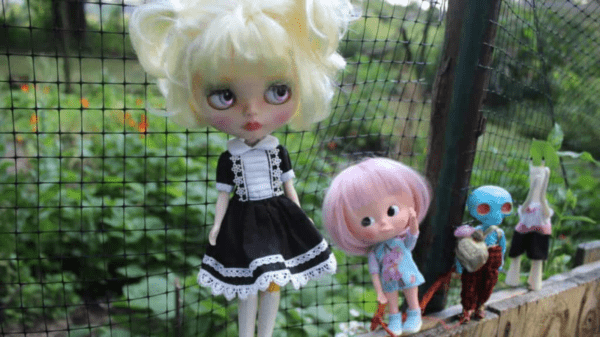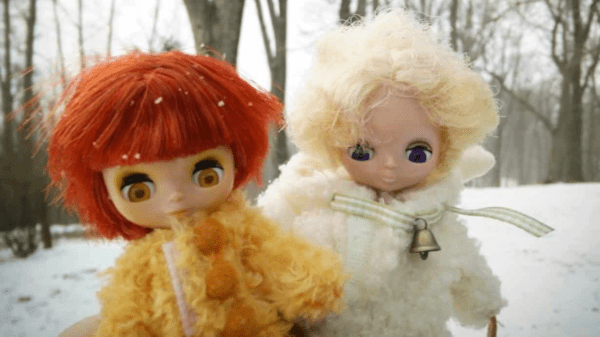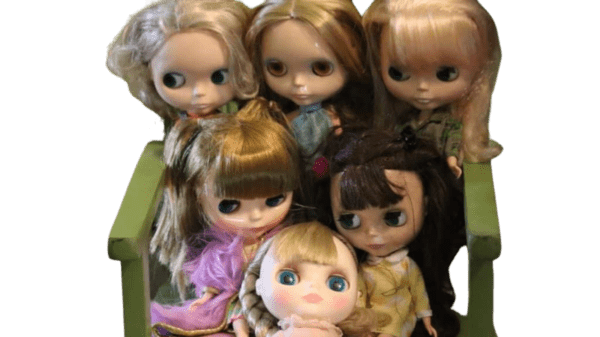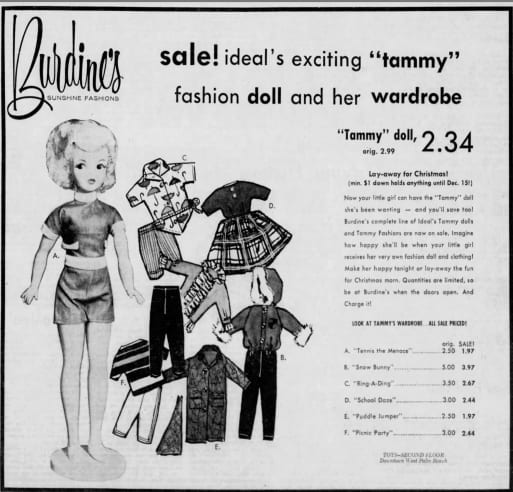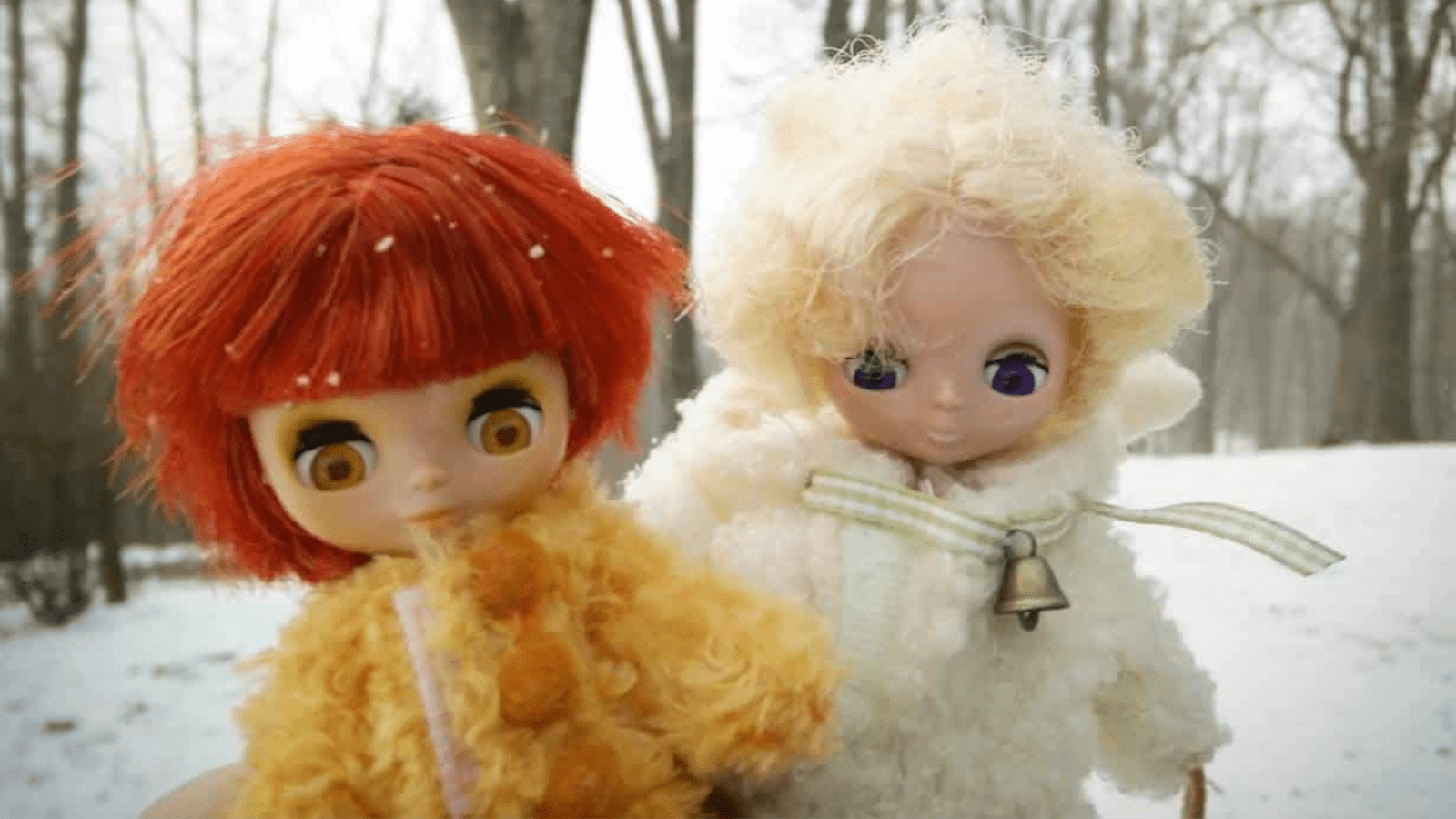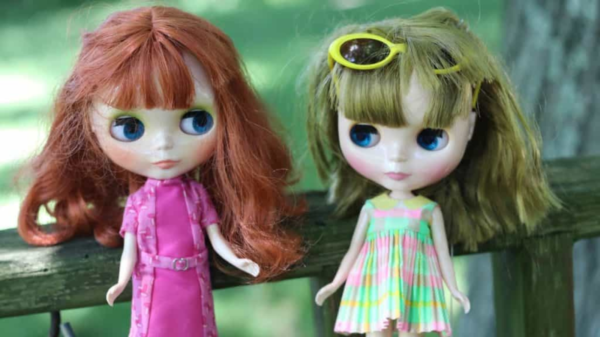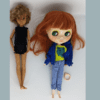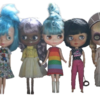What are Petite Blythes and Middie Blythes? What are other types of Blythe and Blythe-like dolls?
Blythe herself is about 11 and a half inches, with some variation depending on whether she’s on a Licca body, a Takara, or has been rebodied onto a jointed one. However, 2001 also saw the invention of Petite Blythe.The first few releases were intended to be keychains to match the style of the bigger dolls, and they even had the same names. After several iterations, they were made with sleep eyes. Their eyes do not change or move, however. They are four inches tall and there are more than 200 types of them.
Middie arrived in 2010, and has had many subsequent releases. She is eight inches tall, and only one eye color. However, a button on the back of her head changes her gaze from left, to straight ahead, to right.
What is Littlest Pet Shop Blythe?
In 2010, Littlest Pet Shop released Blythe and Littlest Petshop sets. Hasbro has made Littlest Pet Shop since the 1990s, and they also gobbled up Kenner, so the cross-promotion is fitting! Their Blythes look a lot like the petite models, except that they don’t have sleep eyes. LPS even made a girl named Blythe the start of their cartoon show. LPS stopped making these sets, but unopened ones can be found on Ebay for around $25-50. Loose used girls can be found for just a few dollars if you keep your eyes open.
What about factory Blythe? What is a factory or TBL Blythe?
The story goes that factory or Taobao (a Chinese website) Blythe were once based on actual stolen parts from the Takara factory. Their original origin is a mystery, and continues to be one, but these copies are now EVERYWHERE, on Ebay, as bases for custom dolls on Etsy, on Chinese sites such as AliExpress, and even more recently on Amazon.com.
Some collectors might feel iffy about buying unofficial Blythes. However, I would argue that by calling them factory Blythes, it enables anyone who does a little research to understand that it is not an official Takara doll.
Factory Blythe often have wilder hair colors than official releases (and that my have influenced Takara to start experimenting themselves). They also often have nicer hair than official releases, which collectors sometimes complain are greasy or thin on certain dolls.
They can often be seen sold on jointed bodies (though anyone can by a Neemo or Azone body and do a little surgery on an official Blythe in order to get one with more movement). Factory Blythe can be bought for as little as $45. They’re not a bad option for someone who wants to try their hand at customizing, or for someone who isn’t sure if they really MUST HAVE a Blythe. Again, my argument is that it is up to the savvy buyer to choose. You can also find factory Middies and Petite dolls, if you’re curious about which kind you want to find.
What was the original Blythe?
The now-defunct Kenner toy company made the original Blythe doll in 1972. Blythe came in four hair colors: brown, black, red, and blonde. Every color except blonde came in chunky bangs, thin bangs, side parts, and middle parts. She had fabulous clothes, and even some wigs and extra accessories.
Apparently, Blythe’s color-changing eyes, reportedly inspired by a trend of wearing colored contact lenses, were spooky to children. Designer Allison Katzman’s baby was doomed to be a cult classic toy that took three decades to blossom into a full-blown craze. The Japanese, and the lovers of kitsch and big eyed, strange toys were patiently waiting to find her.
In 2000, photographer Gina Garan published This is Blythe, a little book of her Kenner Blythe in different poses and situations, and the time was right to finally notice Blythe and her potential to be a model. Doll makers Ashton Drake Galleries released copies of the original Blythe between 2007 and 2009, but when Takara Tomy’s 2001 releasing them, the craze began. The first releases, especially number one, Parco, can now be sold for almost as much as a good condition Kenner. All Gold in One, Rosie Red, and other early releases can be shockingly pricey for dolls from 2001. But then, just like the Kenners, there is a limited supply of them.
Oh, that’s right, the Kenners. Over the years, the price of them has shot up to astounding heights. Never removed from box Blythe sell on Ebay for thousands of dollars. Based on watching Ebay auctions, it looks to me as if even beat up and damaged Kenners can’t be found for less than $400. Redheads appear to be in particularly high demand. There are true dolly tales of people finding a Kenner in a thrift store for $2.99 and such, but even if you did, well, that’d be quite a profit if you sold it! (I’ve gone through this in my imagination, trust me.)
Kenners do have a unique look. Even the ADG can’t duplicate it. Vintage is vintage, and the unique, subtle ways that Kenner age and lose their makeup or frizz their hair can add to that charm. But for the foreseeable future, that charm comes with quite a price tag.
What is an Icy doll? What is a Basaak? What is a CCE (color-changing eyes) doll?
On the opposite end of the Kenner spectrum are the obvious Blythe clones. My favorite is Basaak, which can be found on Amazon from $28-35. The sellers of it I have found don’t let you pick the hair color, which can be annoying, but also adds a little mystery to the experience. Basaak is clearly a Blythe clone, but she’s the best-looking one. She’s perfect for a younger child who isn’t ready to be as careful with their toy, or for someone who isn’t sure if they’re going to catch the doll fever, but wants to try it out. Basaak comes with some cheap, Barbie-ish high heels and two outfits. She also is in a very Blythe-like box, that at least honestly says Basaak and not, say, “Blyth” (yes, they exist). One unfortunate difference with Basaak is that her feet are permanently in a Barbie-like high heel pose instead of the softer, malleable feet of other models. Her eyechips are also notoriously difficult to remove [link to eventual eyechip removal article], and you may find you need to break them if attempting to do so.
CCE, Blybe, Little Bighead doll and others were more contemporary to Blythe’s first triumphant return. To me, they look much cheaper and less like Blythe than Basaak does, and at this point can’t be found for any cheaper so why not stick with a Basaak that can be at your door in two days with Amazon prime? If you are interested in the other models, however, browsing ebay might bring up some options.
Icy Dolls, on the other hand, aren’t quite a Blythe clone. Though Amazon sellers always aggressively appeal to buyers who might want to customize their Icy and make it look like a Blythe, Icy have their own look. It’s not as waif-like as Blythe, but it’s appealing as well. Customizers agree, and you can find some beautiful examples of people giving Icy as much love and attention as they do Blythe, with very nice results. Certainly, Bazaak, Icy, factory Blythes, and originals can all be friends.



